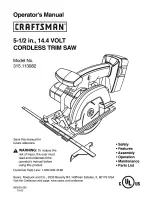
6
English
A. Table
B. Miter gauge
C. Blade
D. Blade guard assembly
E. Fence
F. Fence rails
G. Rip fence front/rear latch
H. Fine adjustment knob
I. Blade height adjustment wheel
J. Bevel lock lever
K. ON/OFF switch
L. Rip fence indicator
M. Adjustable feet
N. Mounting holes
O. Cord wrap
P. Handle
Q. Anti-kickback assembly
R. Rip fence locator pins
S. Dust collection port
T. Dust shroud
U. Push stick
V. Arbor wrench, spindle wrench
W. Rail lock lever
ASSEMBLY
WARNING: Shock Hazard. To reduce the risk of serious personal injury, turn unit
off and disconnect machine from power source before attempting to move it, change
accessories or make any adjustments.
ASSEMBLE YOUR SAW IN THE FOLLOWING ORDER
1. Rip fence (
NOTE:
Adjust rip scale before proceeding; refer to
Rip Scale Adjustment
under
Adjustment.
)
2. Position riving knife
3. Anti-kickback assembly
4. Blade guard assembly
5. Miter gauge (if required for application)
NOTE:
No tools needed for assembly.
NOTE:
Wrenches included with this saw are to remove and replace blades.
Assembling the Rip Fence (Fig. 3–5)
The rip fence can be installed in two positions on the right (Position 1 for 0" to 20" ripping, and
Position 2 for 4" to 24" ripping) and one position on the left of your table saw.
1. Align the locator pin (R) on the fence rail with the fence head slot and align the latch (G)
with the opening (AA).
2. Secure the rip fence by snapping the latches onto the rails as shown in Figure 5. Be sure
to snap both front and rear latches (G) in place.
FIG. 5
FIG. 4
G
AA
R
To Remove the Throat Plate (Fig. 6)
1. Remove the throat plate (X) by turning the cam lock knob (CC) 1/4 turn counterclockwise.
2. Using finger hole (XX) on the plate, pull throat plate up and forward to expose the inside of
the saw.
FIG. 7
A1
ZZ
YY
FF
CC
XX
X
FIG. 6
Positioning the Riving Knife (Fig. 7–9)
1. Raise the saw blade arbor to its maximum height.
2. Loosen the riving knife lock knob (YY) (minimum of three turns).
3. To disengage riving knife lock pin, push lock knob toward the riving knife as indicated by the
yellow arrows on the knob.
YY
FIG. 8
FIG. 9
FF
C
4. Lift and slide the riving knife to the approximate position indicated by the markings (non-thru
and thru-position) on the riving knife and the lock pin will snap into place.
5. Tighten the riving knife lock knob.
WARNING:
Before connecting the table saw to the power source or operating the saw,
always inspect the blade guard assembly and riving knife for proper alignment and clearance
with saw blade. Check alignment after each change of bevel angle.
NOTE:
DO NOT operate saw if riving knife is not locked in the thru cut (ZZ) or non-thru cut
position (A1) hole.
When properly aligned, the riving knife will be in line with the blade at both table top level, and at
the top of the blade. Using a straight edge, ensure that the blade (C) is aligned with the riving
knife (FF) as shown in Figure 9. With power disconnected, operate the blade tilt and height
adjustments through the extremes of travel and ensure the blade guard assembly clears the blade
in all operations and that the anti-kickback assembly is functioning.
To Replace the Throat Plate (Fig. 6)
1. Align the throat plate as shown in Figure 6, and insert the tabs on the back of the throat
plate into the holes on the back of the table opening.







































